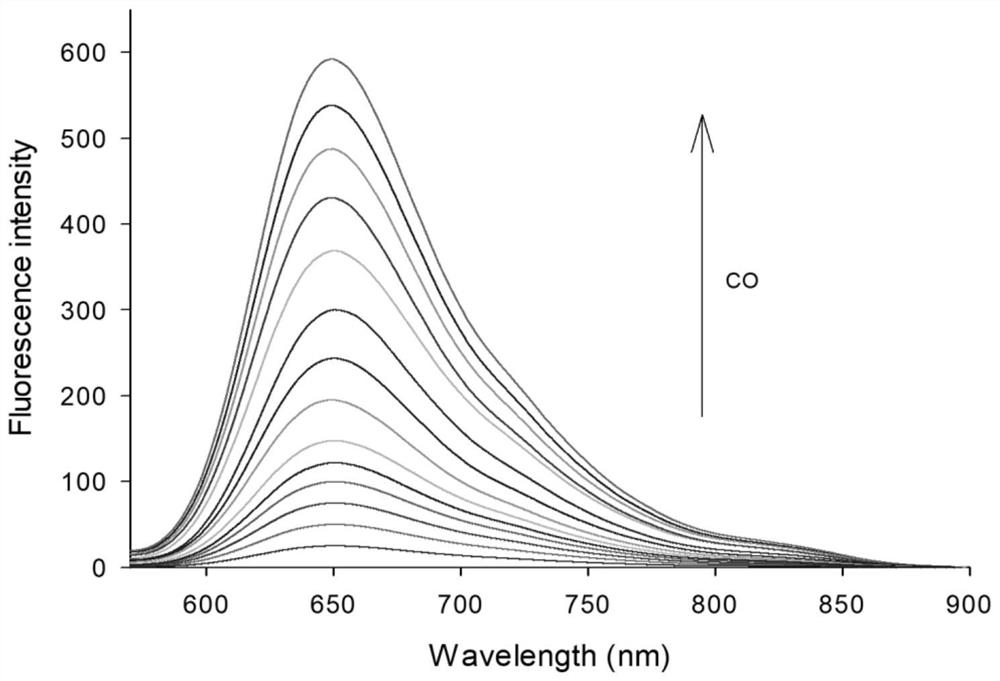Preparation and application of a solid-state fluorescent probe for detecting carbon monoxide
A solid-state fluorescence and carbon monoxide technology, applied in the field of fluorescent probes, can solve the problems of short wavelength and limited application of solid-state fluorescent probes
- Summary
- Abstract
- Description
- Claims
- Application Information
AI Technical Summary
Problems solved by technology
Method used
Image
Examples
Embodiment 1
[0028] Synthesis of solid-state fluorescent probes
[0029] Synthetic route such as figure 1 .
[0030] The synthesis method of solid-state fluorophore HPQ-MQ-OH: 0.35g 1-ethyl-2-methylquinoline (1mmol), 0.30g3-(6-chloro-3,4-dihydro-4-oxo- 2-Quinazolinyl)-4-hydroxybenzaldehyde (1 mmol) and 20.0 mL of acetonitrile were successively added into a 100 mL round bottom flask. Then, under the protection of nitrogen, 0.2 mL of piperidine was added with a micro injector, and the reaction was stirred and refluxed at 80°C for 15 h, and the solvent was removed by distillation under reduced pressure. The solid product was dissolved in dichloromethane, extracted three times with saturated brine, the lower organic phase was dried, filtered and evaporated, and the solid product was extracted with CH 2 Cl 2 / CH 3 OH=100:7 (volume ratio) was used as the eluent for column chromatography to obtain 0.22 g of a reddish-brown solid product (HPQ-MQ-OH), with a yield of 50%.
[0031] The synthes...
Embodiment 2
[0033] Preparation of solid-state fluorescent probe and CO solution
[0034] Preparation of probe solution: Weigh a certain amount of probe and dissolve it in dimethyl sulfoxide to make 1×10 -4 M probe solution. At the same time, weigh a certain amount of PdCl 2 Dissolved in twice distilled water to make 1×10 -4 M's solution. Preparation of CO solution: Dissolve a certain amount of CORM-3 in double distilled water, transfer it to a 500mL volumetric flask, add water to the mark, and obtain a concentration of 1.0×10 -3 CORM-3 of M. will be 1.0×10 -3 The CORM-3 solution of M was gradually diluted to obtain 1.0 × 10 -6 -1.0×10 -3 mol L -1 CORM-3 aqueous solution. Mix 1.0 mL of probe solution, 1.0 mL of PdCl 2 Solution and 1.0mL of CORM-3 aqueous solution were added to a 10mL volumetric flask, and after constant volume with buffer solution, the concentration was 1.0×10 -5 M fluorescent probe and PdCl 2 , 1.0×10 -7 -1.0×10 -4 M of CO mixed with the solution to be teste...
Embodiment 3
[0036] Measurement of Fluorescence Spectrum of Solid State Fluorescent Probe Interaction with CO
[0037] figure 2 For the fluorescence spectrum of the solid-state fluorescent probe interacting with CO, the solid-state fluorescent probe and Pd 2+ The concentrations of CO are 10 μM, and the CO concentrations are: 0, 0.1, 0.5, 1, 5, 10, 20, 30, 40, 50, 60, 70, 80, 90, 100 μM. The excitation wavelength is fixed at 550nm, and the emission wavelength range is 620-670nm. The slit width is 5.0 nm / 5.0 nm, and the fluorescence measurement instrument used is a Hitachi F4600 fluorescence spectrophotometer. from figure 2 It can be seen that the probe itself emits only weak fluorescence due to the quenching effect of allyl formate. Join Pd 2+ After and CO, an obvious emission peak appeared at 650 nm. This is because Pd 2+ First reduced to Pd by CO 0 , which subsequently mediates the Tsuji-Trost reaction, resulting in the cleavage of the allyl formate, releasing the fluorophore, t...
PUM
 Login to View More
Login to View More Abstract
Description
Claims
Application Information
 Login to View More
Login to View More - R&D
- Intellectual Property
- Life Sciences
- Materials
- Tech Scout
- Unparalleled Data Quality
- Higher Quality Content
- 60% Fewer Hallucinations
Browse by: Latest US Patents, China's latest patents, Technical Efficacy Thesaurus, Application Domain, Technology Topic, Popular Technical Reports.
© 2025 PatSnap. All rights reserved.Legal|Privacy policy|Modern Slavery Act Transparency Statement|Sitemap|About US| Contact US: help@patsnap.com



